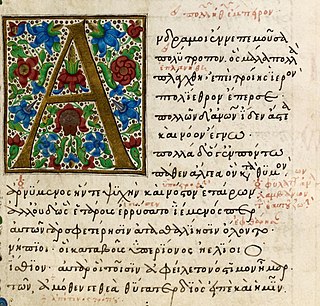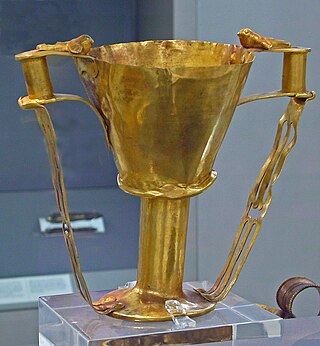
The Odyssey is one of two major ancient Greek epic poems attributed to Homer. It is one of the oldest works of literature still widely read by modern audiences. Like the Iliad, the Odyssey is divided into 24 books. It follows the Greek hero Odysseus, king of Ithaca, and his journey home after the Trojan War. After the war, which lasted ten years, his journey from Troy to Ithaca, via Africa and southern Europe, lasted for ten additional years during which time he encountered many perils and all of his crewmates were killed. In his absence, Odysseus was assumed dead, and his wife Penelope and son Telemachus had to contend with a group of unruly suitors who were competing for Penelope's hand in marriage.
Alastor refers to a number of people and concepts in Greek mythology:

In Greek and Roman mythology, the Giants, also called Gigantes, were a race of great strength and aggression, though not necessarily of great size. They were known for the Gigantomachy, their battle with the Olympian gods. According to Hesiod, the Giants were the offspring of Gaia (Earth), born from the blood that fell when Uranus (Sky) was castrated by his Titan son Cronus.

Ischia is a volcanic island in the Tyrrhenian Sea. It lies at the northern end of the Gulf of Naples, about 30 kilometres from the city of Naples. It is the largest of the Phlegrean Islands. Although inhabited since the Bronze Age, as a Greek emporium it was founded in the 8th or 9th century BCE, and known as Πιθηκοῦσαι, Pithekoūsai.

Posidippus of Pella was an Ancient Greek epigrammatic poet.

Martin Litchfield West, was a British philologist and classical scholar. In recognition of his contribution to scholarship, he was appointed to the Order of Merit in 2014.
In ancient Greece the chief magistrate in various Greek city states was called eponymous archon. "Archon" means "ruler" or "lord", frequently used as the title of a specific public office, while "eponymous" means that he gave his name to the year in which he held office, much like the Roman dating by consular years.
In Greek mythology, the Lampads or Lampades are torch-bearing nymphs who follow the goddess Hecate.

Totenpass is a German term sometimes used for inscribed tablets or metal leaves found in burials primarily of those presumed to be initiates into Orphic, Dionysiac, and some ancient Egyptian and Semitic religions. The term may be understood in English as a "passport for the dead". The so-called Orphic gold tablets are perhaps the best-known example.
Ophryneion or Ophrynium was an ancient Greek city in the northern Troad region of Anatolia. Its territory was bounded to the west by Rhoiteion and to the east by Dardanus. It was located about 1.5 km north-east of the village of Erenköy in Çanakkale Province, Turkey. The city was situated on the steep brow of a hill overlooking the Dardanelles, hence the origin of its Ancient Greek name ὀφρῦς (ophrus), meaning 'brow of a hill', 'crag'.
Richard Charles Murray Janko is an Anglo-American classical scholar and the Gerald F. Else Distinguished University Professor of Classical Studies at the University of Michigan.
Dorieus was a Spartan prince of the Agiad dynasty who is mentioned several times in Herodotus. The second son of Anaxandridas II, he was the younger half-brother of Cleomenes I and the elder full brother of both Leonidas I and Cleombrotus. He tried to found a colony in Cinyps (Libya) but failed. He tried again to establish a colony in western Sicily, but was killed by the Carthaginians.
Marcus Lollius was a Roman Senator who was active in the second half of 1st century BC and first half of 1st century. He is best remembered as the father of empress Lollia Paulina.
Peter Allan Hansen was a Danish classical philologist known principally for his work on the Carmina epigraphica graeca I-II and on other aspects of Greek epigraphy. Born in Copenhagen he was educated at Copenhagen University and at Brasenose College, Oxford, where he was a pupil of Lilian H. Jeffery. After 1975 he settled in Oxford and through the support of scholarships and grants continued his work on Hesychios and epigraphy there.
Stephen Victor Tracy is an American scholar of Classics specializing in ancient Greek Epigraphy. Inscriptions are one of the most important classes of primary evidence that comes down to us from antiquity. Tracy is best known for devising a method for recognizing the work of individual inscribers. It was long thought that the intractability of the medium made this impossible. But by treating the inscribed letters as a kind of handwriting he has been able to establish careers for many cutters, to join discrete fragments, to date inscriptions more accurately than in the past, and often thereby make it possible to reach a new understanding of historical events.
The Philinna Papyrus is part of a collection of ancient Greek spells written in hexameter verse. Three spells are partially preserved on the papyrus. One is a cure for headache, one probably for a skin condition, and the purpose of the third spell is uncertain. Two fragments of the papyrus survive, in the collections of the Morgan Library & Museum, New York, and the Berlin State Museums.

The Cup of Nestor or dove cup is a gold goblet discovered in 1876 by Heinrich Schliemann in Shaft IV of Grave Circle A, Mycenae, which is usually dated to the 16th century BC. It is now in the National Archaeological Museum, Athens.

In Greek mythology, Nestor's Cup is a legendary golden mixing cup which was owned by the hero Nestor. The cup is described in the Iliad, and possibly appeared elsewhere in the Epic Cycle. Despite its brief appearance in the Iliad, the cup was the subject of significant attention from ancient commentators on Homer.
Christopher A. Faraone is an American classicist. He is the Edward Olson Distinguished Service Professor in the Department of Classics and the College at the University of Chicago. His work largely covers the study of Ancient Greek poetry, religion and magic, from sources such as text, myths, rituals, and hymns, and from objects such as pottery, papyrus, inscriptions on gems, curse tablets, and figurines or effigies. Faraone is considered to be a foremost scholar on ancient Mediterranean magic.










